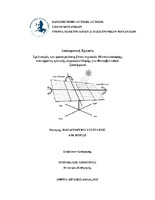| dc.contributor.advisor | Piromalis, Dimitrios | |
| dc.contributor.author | Παπαγεωργίου, Ευστράτιος | |
| dc.date.accessioned | 2023-08-28T11:54:09Z | |
| dc.date.available | 2023-08-28T11:54:09Z | |
| dc.date.issued | 2023-07-20 | |
| dc.identifier.uri | https://polynoe.lib.uniwa.gr/xmlui/handle/11400/4948 | |
| dc.identifier.uri | http://dx.doi.org/10.26265/polynoe-4786 | |
| dc.description.abstract | Στην παρούσα διπλωματική εργασία έγινε σχεδιασμός και προσομοίωση, βάσει τεχνικών μοντελοποίησης, ενός συστήματος ηλιακής παρακολούθησης για Φωτοβολταϊκά Συστήματα. Αυτό το πλήρως αυτόματο σύστημα ανιχνεύει τη θέση του ήλιου ανεξάρτητα από το αν ο ήλιος είναι ορατός ή όχι και έχει την ικανότητα περιστροφής στον άξονα Χ και στον άξονα Υ. Εάν ο ήλιος είναι ορατός, η θέση του ανιχνεύεται από αισθητήρες φωτός και εάν δεν είναι ορατός, η θέση του ανιχνεύεται από τις εξισώσεις του ήλιου που υπολογίζουν τη θέση του στον ουρανό. Το σύστημα προσομοιώθηκε στο Simulink και δημιουργήθηκαν κατάλληλα δομικά στοιχεία διαγράμματα για την επιτυχή προσομοίωση. Οι αισθητήρες φωτός αποτελούνται από εξαιρετικά ευαίσθητες φωτοδιόδους. Το σύστημα ελέγχεται με τη βοήθεια της πλατφόρμας Arduino MEGA 2560 και συγκεκριμένα με τον μικροελεγκτή ATmega2560 της AVR. Ένα άλλο χαρακτηριστικό της υλοποίησης αυτού του συστήματος είναι ότι μπορεί να αναπτυχθεί και να λειτουργήσει χωρίς να υπάρχει κάποιος περιορισμός στα γεωμορφολογικά στοιχεία του τόπου που θα τοποθετηθεί. Επίσης υπάρχει ένα εκτεταμένο φάσμα υποστήριξης μικροελεγκτή και λογισμικού καθώς υπάρχει η ευχέρεια της συνεργασίας του συστήματος με το MATLAB/Simulink το οποίο μπορεί να παράγει αυτόματο κώδικα σε γλώσσα C. Τέλος, ένα άλλο χαρακτηριστικό του συστήματος είναι ότι η πληροφορία της ώρας που απαιτείται για τον υπολογισμό της θέσης του ήλιου μέσο των εξισώσεων προέρχεται από ένα πραγματικό ρολόι (το οποίο μπορεί να ρυθμιστεί από τον χρήστη ανάλογα με τις αλλαγές της ώρας). | el |
| dc.format.extent | 133 | el |
| dc.language.iso | el | el |
| dc.publisher | Πανεπιστήμιο Δυτικής Αττικής | el |
| dc.rights | Αναφορά Δημιουργού - Μη Εμπορική Χρήση - Παρόμοια Διανομή 4.0 Διεθνές | * |
| dc.rights | Attribution-NonCommercial-NoDerivatives 4.0 Διεθνές | * |
| dc.rights.uri | http://creativecommons.org/licenses/by-nc-nd/4.0/ | * |
| dc.subject | Συστήματα ηλιακής παρακολούθησης | el |
| dc.subject | Ανιχνευτής τεταρτημόριου | el |
| dc.subject | Μοντελοποίηση | el |
| dc.subject | Προσομοίωση | el |
| dc.subject | Εξισώσεις του ήλιου | el |
| dc.subject | MATLAB | el |
| dc.subject | Simulink | el |
| dc.subject | Φωτοβολταϊκά συστήματα | el |
| dc.subject | Arduino | el |
| dc.title | Σχεδιασμός και προσομοίωση βάσει τεχνικών μοντελοποίησης συστήματος ηλιακής παρακολούθησης για φωτοβολταϊκά συστήματα | el |
| dc.title.alternative | Model-based design and simulation of a solar tracking system for PV | el |
| dc.type | Διπλωματική εργασία | el |
| dc.contributor.committee | Βόκας, Γεώργιος | |
| dc.contributor.committee | Καμινάρης, Σταύρος | |
| dc.contributor.faculty | Σχολή Μηχανικών | el |
| dc.contributor.department | Τμήμα Ηλεκτρολόγων και Ηλεκτρονικών Μηχανικών | el |
| dc.description.abstracttranslated | In this thesis, a solar monitoring system for Photovoltaic Systems was designed and simulated, based on modeling techniques. This fully automatic system detects the position of the sun regardless of whether the sun is visible or not and has the ability to rotate in the X-axis and Y-axis. If the sun is visible, its position is detected by light sensors and if it is not visible, its position is detected by sun equations that calculate its position in the sky. The system was simulated in Simulink and appropriate block diagrams were created for successful simulation. The light sensors consist of highly sensitive photodiodes. The system is controlled with the help of the Arduino MEGA 2560 platform, specifically the AVR ATmega2560 microcontroller. Another feature of this system implementation is that it can be deployed and operated without any restriction on the geomorphological features of the site where it will be placed. There is also an extensive range of microcontroller and software support as there is the facility for the system to work with MATLAB/Simulink which can generate automatic code in C language. Finally, another feature of the system is that the time information required to calculate the position of the sun in the middle of the equations is derived from a real clock (which can be adjusted by the user according to time changes). | el |


